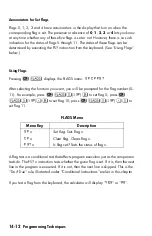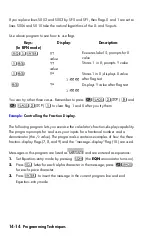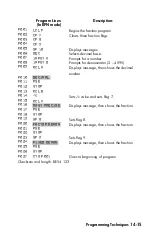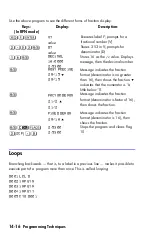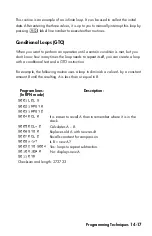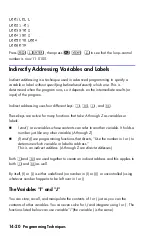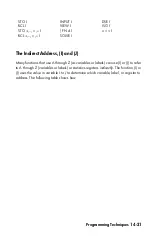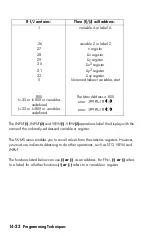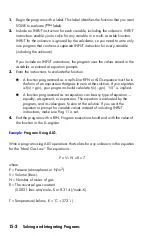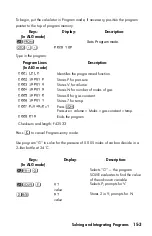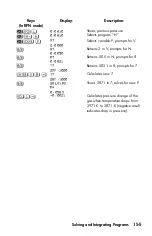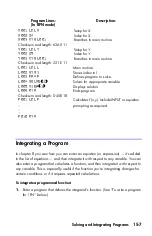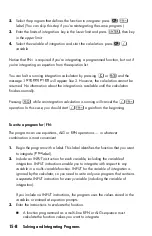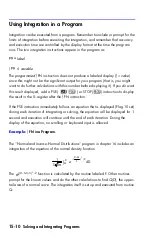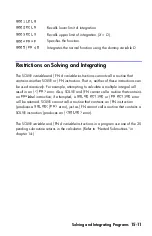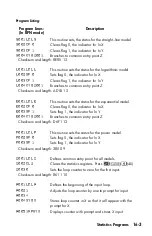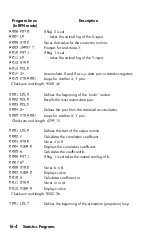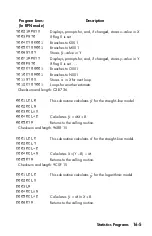
15-2
Solving and Integrating Programs
1.
Begin the program with a
label
. This label identifies the function that you want
SOLVE to evaluate (
label
).
2.
Include an INPUT instruction for each variable, including the unknown. INPUT
instructions enable you to solve for any variable in a multi–variable function.
INPUT for the
unknown
is ignored by the calculator, so you need to write only
one program that contains a
separate
INPUT instruction for
every
variable
(including the unknown).
If you include no INPUT instructions, the program uses the values stored in the
variables or entered at equation prompts.
3.
Enter the instructions to evaluate the function.
A function programmed as a multi–line RPN or ALG sequence must be in
the form of an expression that goes to zero at the solution. If your equation
is
f(x)
=
g(x)
, your program should calculate
f(x)
–
g(x).
"=0" is implied.
A function programmed as an equation can be any type of equation —
equality, assignment, or expression. The equation is evaluated by the
program, and its value goes to zero at the solution. If you want the
equation to prompt for variable values instead of including INPUT
instructions, make sure flag 11 is set.
4.
End the program with a RTN. Program execution should end with the value of
the function in the X–register.
Example:
Program Using ALG.
Write a program using ALG operations that solves for any unknown in the equation
for the "Ideal Gas Law." The equation is:
P x V= N x R x T
where
P = Pressure (atmospheres or N/m
2
).
V = Volume (liters).
N = Number of moles of gas.
R = The universal gas constant
(0.0821 liter–atm/mole–K or 8.314 J/mole–K).
T = Temperature (kelvins; K = °C + 273.1).
Summary of Contents for 35s
Page 1: ...HP 35s scientific calculator user s guide H Edition 1 HP part number F2215AA 90001 ...
Page 14: ...12 Contents ...
Page 15: ...Part 1 Basic Operation ...
Page 16: ......
Page 46: ...1 30 Getting Started ...
Page 63: ...RPN The Automatic Memory Stack 2 17 A Solution ...
Page 64: ...2 18 RPN The Automatic Memory Stack ...
Page 74: ...3 10 Storing Data into Variables ...
Page 180: ...12 14 Statistical Operations ...
Page 181: ...Part 2 Programming ...
Page 182: ......
Page 246: ...15 12 Solving and Integrating Programs ...
Page 270: ...16 24 Statistics Programs ...
Page 284: ...17 14 Miscellaneous Programs and Equations ...
Page 285: ...Part 3 Appendixes and Reference ...
Page 286: ......
Page 308: ...B 8 User Memory and the Stack ...
Page 322: ...C 14 ALG Summary ...
Page 336: ...D 14 More about Solving ...
Page 346: ...E 10 More about Integration ...
Page 352: ...F 6 Messages ...
Page 370: ...G 18 Operation Index ...
Page 382: ...Index 12 ...

